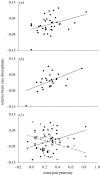Sperm competition and sexually size dimorphic brains in birds
- PMID: 15695206
- PMCID: PMC1634951
- DOI: 10.1098/rspb.2004.2940
Sperm competition and sexually size dimorphic brains in birds
Abstract
Natural selection may favour sexually similar brain size owing to similar selection pressures in males and females, while sexual selection may lead to sexually dimorphic brains. For example, sperm competition involves clear-cut sex differences in behaviour, as males display, mate guard and copulate with females, while females choose among males, and solicit or reject copulations. These behaviours may require fundamentally different neural government in the two sexes leading to sex-dependent brain evolution. Using two phylogenetic approaches in a comparative study, we tested for roles of both natural and sexual-selection pressures on brain size evolution of birds. In accordance with the natural-selection theory, relative brain size of males coevolved with that of females, which may be the result of adaptation to similar environmental constraints such as feeding innovation. However, the mode of brain size evolution differed between the sexes, and factors associated with sperm competition as reflected by extra-pair paternity may give rise to sexually size dimorphic brains. Specifically, species in which females have larger brains than males were found to have a higher degree of extra-pair paternity independently of potentially confounding factors, whereas species in which males have relatively larger brains than females appeared to have lower rates of extra-pair paternity. Hence, the evolution of sperm competition may select for complex behaviours together with the associated neural substrates in the sex that has a higher potential to control extra-pair copulations at the observed levels. Brain function may thus be affected differently in males and females by sexual selection.
Figures



Similar articles
-
Measuring Pre- and Post-Copulatory Sexual Selection and Their Interaction in Socially Monogamous Species with Extra-Pair Paternity.Cells. 2021 Mar 11;10(3):620. doi: 10.3390/cells10030620. Cells. 2021. PMID: 33799610 Free PMC article.
-
Sperm competition in birds.Rev Reprod. 1998 May;3(2):123-9. doi: 10.1530/ror.0.0030123. Rev Reprod. 1998. PMID: 9685191 Review.
-
Testosterone, testes size, and mating success in birds: a comparative study.Horm Behav. 2005 Apr;47(4):389-409. doi: 10.1016/j.yhbeh.2004.11.008. Horm Behav. 2005. PMID: 15777805 Review.
-
Extra-pair copulation and sperm competition in the zebra finch.Nature. 1988 Jul 7;334(6177):60-2. doi: 10.1038/334060a0. Nature. 1988. PMID: 3386741
-
Sexual selection, germline mutation rate and sperm competition.BMC Evol Biol. 2003 Apr 18;3:6. doi: 10.1186/1471-2148-3-6. Epub 2003 Apr 18. BMC Evol Biol. 2003. PMID: 12702218 Free PMC article.
Cited by
-
Brain size as a driver of avian escape strategy.Sci Rep. 2015 Jul 3;5:11913. doi: 10.1038/srep11913. Sci Rep. 2015. PMID: 26139474 Free PMC article.
-
High levels of liver antioxidants are associated with life-history strategies characteristic of slow growth and high survival rates in birds.J Comp Physiol B. 2012 Oct;182(7):947-59. doi: 10.1007/s00360-012-0671-x. Epub 2012 May 10. J Comp Physiol B. 2012. PMID: 22573032
-
Environmental Influences on Neuromorphology in the Non-Native Starling Sturnus vulgaris.Brain Behav Evol. 2018;92(1-2):63-70. doi: 10.1159/000491672. Epub 2018 Sep 13. Brain Behav Evol. 2018. PMID: 30212810 Free PMC article.
-
Comparative analysis of classic brain component sizes in relation to flightiness in birds.PLoS One. 2014 Mar 17;9(3):e91960. doi: 10.1371/journal.pone.0091960. eCollection 2014. PLoS One. 2014. PMID: 24637884 Free PMC article.
-
Longevity is associated with relative brain size in birds.Ecol Evol. 2017 Apr 9;7(10):3558-3566. doi: 10.1002/ece3.2961. eCollection 2017 May. Ecol Evol. 2017. PMID: 28515891 Free PMC article.
References
-
- Andersson M. Sexual selection. Princeton University Press; Princeton, NJ: 1994.
-
- Armstrong E., Bergeron R. Relative brain size and metabolism in birds. Brain Behav. Evol. 1985;26:141–153. - PubMed
-
- Barton R.A. Visual specialization and brain evolution in primates. Proc. R. Soc. B. 1998;265:1933–1937. doi:10.1098/rspb.1998.0523 - DOI - PMC - PubMed
-
- Barton R.A., Harvey P.H. Mosaic evolution of brain structure in mammals. Nature. 2000;405:1055–1058. - PubMed
-
- Bennett P.M., Harvey P.H. Relative brain size and ecology in birds. J. Zool. Lond. 1985;207:151–169.
Publication types
MeSH terms
LinkOut - more resources
Full Text Sources

